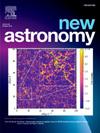Mapping the reddening plane in the Galactic disk through interstellar extinction of open clusters
IF 2.1
4区 物理与天体物理
Q2 ASTRONOMY & ASTROPHYSICS
引用次数: 0
Abstract
As thousands of new open clusters in the Galaxy have recently been reported with reddening or extinction information, we map the distribution and properties of the MilkyWay’s interstellar material in the Galactic disk as traced by these open clusters. By analyzing the distribution of interstellar extinction for 6215 open clusters located at low Galactic latitude (), corresponding to the thin Galactic disk, we identify a reddening plane characterized by a dust layer whose thickness varies with Galactic longitude. By splitting the open clusters sample into several sub-regions of Galactic longitude, we observe that the reddening plane is not perfectly aligned with the formal Galactic plane, but instead varies sinusoidally around the Galactic mid-plane. The maximum and minimum interstellar absorption occur at approximately and , respectively, along the Galactic longitude. Our analysis reveals a noticeable north-south asymmetry in the distribution of interstellar absorption, with a higher proportion of interstellar material below the Galactic plane. We also find that the Sun is located pc above the reddening plane. The scale height of the open clusters from the reddening plane is estimated to be pc. The mean thickness of the absorbing material in the reddening plane, which represents the average extent of the dust layer responsible for interstellar extinction, is found to be about pc. Our findings provide insights into the distribution of interstellar dust, its relationship with the Galactic thin disk, and its implications on the Galactic structure.
通过疏散星团的星际消光绘制银河系盘中的变红平面
由于最近报道了银河系中数千个新的疏散星团的变红或消失信息,我们绘制了由这些疏散星团追踪的银河系盘中星际物质的分布和性质。通过分析6215个位于低银纬(|b|≤6°)的疏散星团的星际消光分布,我们确定了一个以尘埃层为特征的变红平面,其厚度随银经变化。通过将疏散星团样本分成银河系经度的几个子区域,我们观察到变红的平面并不完全与正式的银河系平面对齐,而是围绕银河系中平面呈正弦变化。最大和最小的星际吸收分别发生在沿银河系经度约42°和222°处。我们的分析揭示了星际吸收分布中明显的南北不对称,银河平面以下的星际物质比例更高。我们还发现太阳位于变红平面上方15.7±7.3 pc。从变红平面出发,疏散星团的尺度高度估计为zh=87.3±1.8 pc。在变红的平面上,吸收物质的平均厚度约为201±20pc,这代表了星际消光的尘埃层的平均范围。我们的发现提供了对星际尘埃分布的见解,它与银河系薄盘的关系,以及它对银河系结构的影响。
本文章由计算机程序翻译,如有差异,请以英文原文为准。
求助全文
约1分钟内获得全文
求助全文
来源期刊

New Astronomy
地学天文-天文与天体物理
CiteScore
4.00
自引率
10.00%
发文量
109
审稿时长
13.6 weeks
期刊介绍:
New Astronomy publishes articles in all fields of astronomy and astrophysics, with a particular focus on computational astronomy: mathematical and astronomy techniques and methodology, simulations, modelling and numerical results and computational techniques in instrumentation.
New Astronomy includes full length research articles and review articles. The journal covers solar, stellar, galactic and extragalactic astronomy and astrophysics. It reports on original research in all wavelength bands, ranging from radio to gamma-ray.
 求助内容:
求助内容: 应助结果提醒方式:
应助结果提醒方式:


